Mining the gold to pay for the future
Published on March 11th, 2019
Ron Rosten is involved in organizing the North American Ice Optimist and DN youth sailing program, and is an active iceboater himself based in Madison, WI. Here are his observations on growing iceboating for the next generation.
My son and I attended the 2015 World DN Junior and Ice-Optimist World Championship (JWC) in Lithuania, and we have attended every JWC since then. The JWC is held in Europe in the beginning of February every year and anybody concerned about the future of iceboating should pay close attention to the success of this European regatta.
On top of the 80 kids that participate in the JWC, there are many more active competitors who don’t travel, mostly from the Baltic region. The enthusiasm and energy of the event is something to behold with champions receiving fan mail and featured on national news.
It would be fantastic if one day we could sanction a similar junior regatta here in North America but that doesn’t seem realistic at this time. While we have a huge number of kids here in Wisconsin that compete in summertime youth sailing, and would be perfect candidates for youth iceboating, I guarantee almost every one of those kids is involved in a wintertime activity organized primarily through the school system.
Whether it’s basketball, swimming, indoor soccer, volleyball, hockey, etc, every school district offers something for these soft water sailing kids, and the majority take full advantage of it. It is a significant obstacle for efforts to organize youth iceboating in North America.
Compare that to the kids of Europe, where youth sports exist mostly in the form of independent clubs. For the majority of the European kids that are involved in youth soft water sailing, they have an open schedule in the wintertime.
But all is not lost as there are other things working in our favor. The University of Wisconsin here in Madison (over 43,000 enrollment) has a very active sailing club, the Wisconsin Hoofers, which is one of the oldest, and largest sailing clubs in the USA.
Many college students are living life for the first time with an open weekend not filled with the activities of their youth. In Madison, with the help of University of Wisconsin sailing coach Dave Elsmo, we’ve been able to generate lots of interest in DN sailing through Hoofers, and doing it with surprisingly little effort.
In my humble opinion, the effort to attract the next generation of iceboat competitors here in North America should be focused on the college level, primarily schools in the northern USA and Canada that have an active sailing program.
The current group of DN competitors we have right now is an amazing collection of talent. Just off the top of my head I can think of a very successful marketing executive, a top engineer for a worldwide sailboat manufacturer, and a world champion whose intense passion for the sport could easily win over a room or auditorium. That’s just a few examples.
There’s a gold mine of potential future DN sailors in the collegiate sailing clubs, but the gold is not going to just jump into our pockets; it’s going to take the collective effort of the association to successfully mine the gold.
Editor’s note: While this report is about iceboating, the same idea is effective for warmer sailing areas that remain active through the school year. Even if your local universities have sailing teams, there are plenty of students that seek an alternative. As Ron says, the gold is there but must be mined.









 We’ll keep your information safe.
We’ll keep your information safe.